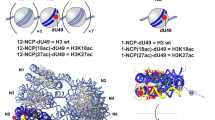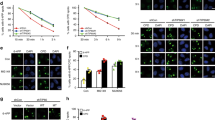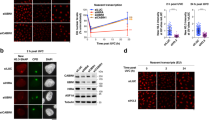Abstract
Post-translational modifications of histone variant H2A.Z accompany gene transactivation, but its modifying enzymes still remain elusive. Here, we reveal a hitherto unknown function of human KAT2A (GCN5) as a histone acetyltransferase (HAT) of H2A.Z at the promoters of a set of transactivated genes. Expression of these genes also depends on the DNA repair complex XPC–RAD23–CEN2. We established that XPC–RAD23–CEN2 interacts both with H2A.Z and KAT2A to drive the recruitment of the HAT at promoters and license H2A.Z acetylation. KAT2A selectively acetylates H2A.Z.1 versus H2A.Z.2 in vitro on several well-defined lysines and we unveiled that alanine-14 in H2A.Z.2 is responsible for inhibiting the activity of KAT2A. Notably, the use of a nonacetylable H2A.Z.1 mutant shows that H2A.Z.1ac recruits the epigenetic reader BRD2 to promote RNA polymerase II recruitment. Our studies identify KAT2A as an H2A.Z.1 HAT in mammals and implicate XPC–RAD23–CEN2 as a transcriptional co-activator licensing the reshaping of the promoter epigenetic landscape.
This is a preview of subscription content, access via your institution
Access options
Access Nature and 54 other Nature Portfolio journals
Get Nature+, our best-value online-access subscription
$29.99 / 30 days
cancel any time
Subscribe to this journal
Receive 12 print issues and online access
$259.00 per year
only $21.58 per issue
Buy this article
- Purchase on Springer Link
- Instant access to full article PDF
Prices may be subject to local taxes which are calculated during checkout






Similar content being viewed by others
Data availability
Data are available on SRA repository under accession number PRJNA517640. Further information and requests for resources and reagents should be directed to the lead contact, F.C. (fredr@igbmc.fr).
References
Brivanlou, A. H. & Darnell, J. E. Jr. Signal transduction and the control of gene expression. Science 295, 813–818 (2002).
Kouzarides, T. Chromatin modifications and their function. Cell 128, 693–705 (2007).
Berger, S. L. The complex language of chromatin regulation during transcription. Nature 447, 407–412 (2007).
Tessarz, P. & Kouzarides, T. Histone core modifications regulating nucleosome structure and dynamics. Nat. Rev. Mol. Cell Biol. 15, 703–708 (2014).
Li, X., Egervari, G., Wang, Y., Berger, S. L. & Lu, Z. Regulation of chromatin and gene expression by metabolic enzymes and metabolites. Nat. Rev. Mol. Cell Biol. 19, 563–578 (2018).
Albig, W. & Doenecke, D. The human histone gene cluster at the D6S105 locus. Hum. Genet. 101, 284–294 (1997).
Banaszynski, L. A., Allis, C. D. & Lewis, P. W. Histone variants in metazoan development. Dev. Cell 19, 662–674 (2010).
Biterge, B. & Schneider, R. Histone variants: key players of chromatin. Cell Tissue Res. 356, 457–466 (2014).
Talbert, P. B. & Henikoff, S. Histone variants on the move: substrates for chromatin dynamics. Nat. Rev. Mol. Cell Biol. 18, 115–126 (2017).
Corujo, D. & Buschbeck, M. Post-translational modifications of H2A histone variants and their role in cancer. Cancers 10, E59 (2018).
Gevry, N., Chan, H. M., Laflamme, L., Livingston, D. M. & Gaudreau, L. p21 transcription is regulated by differential localization of histone H2A.Z. Genes Dev. 21, 1869–1881 (2007).
Barski, A. et al. High-resolution profiling of histone methylations in the human genome. Cell 129, 823–837 (2007).
Valdes-Mora, F. et al. Acetylation of H2A.Z is a key epigenetic modification associated with gene deregulation and epigenetic remodeling in cancer. Genome Res. 22, 307–321 (2012).
Dryhurst, D. et al. Characterization of the histone H2A.Z-1 and H2A.Z-2 isoforms in vertebrates. BMC Biol. 7, 86 (2009).
Matsuda, R. et al. Identification and characterization of the two isoforms of the vertebrate H2A.Z histone variant. Nucleic Acids Res. 38, 4263–4273 (2010).
Sevilla, A. & Binda, O. Post-translational modifications of the histone variant H2AZ. Stem Cell Res. 12, 289–295 (2014).
Millar, C. B., Xu, F., Zhang, K. & Grunstein, M. Acetylation of H2AZ Lys 14 is associated with genome-wide gene activity in yeast. Genes Dev. 20, 711–722 (2006).
Li, Z. et al. Foxa2 and H2A.Z mediate nucleosome depletion during embryonic stem cell differentiation. Cell 151, 1608–1616 (2012).
Dalvai, M. et al. H2A.Z-dependent crosstalk between enhancer and promoter regulates Cyclin D1 expression. Oncogene 32, 4243–4251 (2013).
Giaimo, B. D. et al. Histone variant H2A.Z deposition and acetylation directs the canonical Notch signaling response. Nucleic Acids Res. 46, 8197–8215 (2018).
Hanawalt, P. C. & Spivak, G. Transcription-coupled DNA repair: two decades of progress and surprises. Nat. Rev. Mol. Cell Biol. 9, 958–970 (2008).
Fong, Y. W., Cattoglio, C. & Tjian, R. The intertwined roles of transcription and repair proteins. Mol. Cell. 52, 291–302 (2013).
Bidon, B. et al. XPC is an RNA polymerase II cofactor recruiting ATAC to promoters by interacting with E2F1. Nat. Commun. 9, 2610 (2018).
Fong, Y. W. et al. A DNA repair complex functions as an oct4/sox2 coactivator in embryonic stem cells. Cell 147, 120–131 (2011).
Araki, M. et al. Centrosome protein centrin 2/caltractin 1 is part of the xeroderma pigmentosum group C complex that initiates global genome nucleotide excision repair. J. Biol. Chem. 276, 18665–18672 (2001).
Zhang, E. T. et al. Architecture of the human XPC DNA repair and stem cell coactivator complex. Proc. Natl Acad. Sci. USA 112, 14817–14822 (2015).
Nishi, R. et al. UV-DDB-dependent regulation of nucleotide excision repair kinetics in living cells. DNA Rep. 8, 767–776 (2009).
Renaud, E. et al. Differential contribution of XPC, RAD23A, RAD23B and CENTRIN 2 to the UV-response in human cells. DNA Rep. 10, 835–847 (2011).
Koch, S. et al. Cockayne syndrome protein A is a transcription factor of RNA polymerase I and stimulates ribosomal biogenesis and growth. Cell Cycle 13, 2029–2037 (2014).
Obri, A. et al. ANP32E is a histone chaperone that removes H2A.Z from chromatin. Nature 505, 648–653 (2014).
Ng, J. M. et al. A novel regulation mechanism of DNA repair by damage-induced and RAD23-dependent stabilization of xeroderma pigmentosum group C protein. Genes Dev. 17, 1630–1645 (2003).
Fournier, M. et al. KAT2A/KAT2B-targeted acetylome reveals a role for PLK4 acetylation in preventing centrosome amplification. Nat. Comm. 7, 13227 (2016).
Riss, A. et al. Subunits of ADA-two-A-containing (ATAC) or Spt-Ada-Gcn5-acetyltrasferase (SAGA) coactivator complexes enhance the acetyltransferase activity of GCN5. J. Biol. Chem. 290, 28997–29009 (2015).
Vardabasso, C. et al. Histone variant H2A.Z.2 mediates proliferation and drug sensitivity of malignant melanoma. Mol. Cell 59, 75–88 (2015).
Fu, L. L. et al. Inhibition of BET bromodomains as a therapeutic strategy for cancer drug discovery. Oncotarget 6, 5501–5516 (2015).
Chen, W. & Roeder, R. G. Mediator-dependent nuclear receptor function. Semin. Cell Dev. Biol. 22, 749–758 (2011).
Bonisch, C. & Hake, S. B. Histone H2A variants in nucleosomes and chromatin: more or less stable? Nucleic Acids Res. 40, 10719–10741 (2012).
Keogh, M. C. et al. The Saccharomyces cerevisiae histone H2A variant Htz1 is acetylated by NuA4. Genes Dev. 20, 660–665 (2006).
Babiarz, J. E., Halley, J. E. & Rine, J. Telomeric heterochromatin boundaries require NuA4-dependent acetylation of histone variant H2A.Z in Saccharomyces cerevisiae. Genes Dev. 20, 700–710 (2006).
Shia, W. J., Li, B. & Workman, J. L. SAS-mediated acetylation of histone H4 Lys 16 is required for H2A.Z incorporation at subtelomeric regions in Saccharomyces cerevisiae. Genes Dev. 20, 2507–2512 (2006).
Dalvai, M., Fleury, L., Bellucci, L., Kocanova, S. & Bystricky, K. TIP48/Reptin and H2A.Z requirement for initiating chromatin remodeling in estrogen-activated transcription. PLoS Genet. 9, e1003387 (2013).
Au-Yeung, N. & Horvath, C. M. Histone H2A.Z. suppression of interferon-stimulated transcription and antiviral immunity is modulated by GCN5 and BRD2. iScience 6, 68–82 (2018).
Chen, L. et al. Lysine acetyltransferase GCN5 potentiates the growth of non-small cell lung cancer via promotion of E2F1, cyclin D1, and cyclin E1 expression. J. Biol. Chem. 288, 14510–14521 (2013).
Li, B., Carey, M. & Workman, J. L. The role of chromatin during transcription. Cell 128, 707–719 (2007).
Draker, R. et al. A combination of H2A.Z and H4 acetylation recruits Brd2 to chromatin during transcriptional activation. PLoS Genet. 8, e1003047 (2012).
Cleaver, J. E. Cancer in xeroderma pigmentosum and related disorders of DNA repair. Nat. Rev. Cancer 5, 564–573 (2005).
Bootsma, D., Kraemer, K. H., Cleaver, J. E. & Hoeijmakers, J. H. J. in. The Genetic Basis of Human Cancer 2nd edn (eds Vogelstein, B. & Kinzler, K. W.) 245–274 (McGraw-Hill, 2002).
Denis, G. V., Vaziri, C., Guo, N. & Faller, D. V. RING3 kinase transactivates promoters of cell cycle regulatory genes through E2F. Cell Growth Differ. 11, 417–424 (2000).
Bernardes de Jesus, B. M., Bjoras, M., Coin, F. & Egly, J. M. Dissection of the molecular defects caused by pathogenic mutations in the DNA repair factor XPC. Mol. Cell Biol. 28, 7225–7235 (2008).
Demeny, M. A. et al. Identification of a small TAF complex and its role in the assembly of TAF-containing complexes. PLoS One 2, e316 (2007).
Singh, A., Compe, E., Le May, N. & Egly, J. M. TFIIH subunit alterations causing xeroderma pigmentosum and trichothiodystrophy specifically disturb several steps during transcription. Am. J. Hum. Genet. 96, 194–207 (2015).
Shuaib, M., Ouararhni, K., Dimitrov, S. & Hamiche, A. HJURP binds CENP-A via a highly conserved N-terminal domain and mediates its deposition at centromeres. Proc. Natl Acad. Sci. USA 107, 1349–1354 (2010).
Le May, N. et al. NER factors are recruited to active promoters and facilitate chromatin modification for transcription in the absence of exogenous genotoxic attack. Mol. Cell 38, 54–66 (2010).
Di Cerbo, V. et al. Acetylation of histone H3 at lysine 64 regulates nucleosome dynamics and facilitates transcription. eLife 3, e01632 (2014).
Acknowledgements
We are grateful to A. Hamiche, L. Tora and A. Poterszman (IGBMC, France) for expression vectors and antibodies, to K. Sugasawa (Kobe University, Japan) for the antibodies against CEN2 and to members of our team. We thank L. Tora for critical reading and IGBMC antibody and cell culture facilities. This study was supported by the INCA (2017-11537), the ligue contre le cancer (Equipe labélisée 2019, FC) and the ANR-10-LABX-0030-INRT, a French State fund managed by the Agence Nationale de la Recherche under the frame program Investissements d’Avenir ANR-10-IDEX-0002-02. M.S was supported by ‘le prix d’encouragement à la recherche de la province Sud (New Caledonia)’. G.C. was supported by a PhD fellowship (2214-A) from the Scientific and Technological Research Council of Turkey (TÜBİTAK). Sequencing was performed by the IGBMC Microarray and Sequencing platform, a member of the ‘France Génomique’ consortium (ANR-10-INBS-0009). Note that part of the text in this article may overlap with the published thesis by M. Semer.
Author information
Authors and Affiliations
Contributions
M.S. performed mass spectrometry, RT–PCR and western blot assay determining the interaction between XPC and H2A.Z. B.B. performed the bioinformatics work of ChIP data. G.C. expressed and purified the recombinant human HAT module of the ATAC complex and the catalytically dead KAT2A mutant. A.L. and P.C. performed site-directed mutagenesis and HAT assays. N.L.M. performed ChIP-seq and HAT assays. J.M.E. analyzed results. F.C. and N.L.M. conceived the experiments and supervised the work. F.C. wrote the manuscript with input from N.L.M.
Corresponding authors
Ethics declarations
Competing interests
The authors declare no competing interests.
Additional information
Publisher’s note Springer Nature remains neutral with regard to jurisdictional claims in published maps and institutional affiliations.
Supplementary information
Supplementary Information
Supplementary Figures 1–35, Supplementary Tables 1–3 and title/legend for Supplementary Dataset 1
Supplementary Dataset 1
List of genes co-occupied by XPC and RNAPII.
Rights and permissions
About this article
Cite this article
Semer, M., Bidon, B., Larnicol, A. et al. DNA repair complex licenses acetylation of H2A.Z.1 by KAT2A during transcription. Nat Chem Biol 15, 992–1000 (2019). https://doi.org/10.1038/s41589-019-0354-y
Received:
Accepted:
Published:
Issue Date:
DOI: https://doi.org/10.1038/s41589-019-0354-y
This article is cited by
-
GCN5-mediated regulation of pathological cardiac hypertrophy via activation of the TAK1-JNK/p38 signaling pathway
Cell Death & Disease (2022)
-
TmcA functions as a lysine 2-hydroxyisobutyryltransferase to regulate transcription
Nature Chemical Biology (2022)
-
Structure of HIV-1 Vpr in complex with the human nucleotide excision repair protein hHR23A
Nature Communications (2021)
-
The roles of histone variants in fine-tuning chromatin organization and function
Nature Reviews Molecular Cell Biology (2020)
-
Histone variant H2A.Z facilitates DNA replication
Science China Life Sciences (2020)



